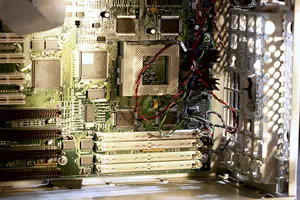 Electronics
Electronics
Technological advances in all electronic equipment, particularly computers, continually shorten their useful life, resulting in a complex and rapidly growing waste stream. Computers, televisions, lab analyzers, EKG monitors and other types of biomedical equipment contain many hazardous constituents from lead in cathode ray tube (CRT) monitors, chlorinated plastics in cable wiring, brominated flame retardants in circuit boards to mercury in LCD displays. CRTs alone contribute almost one third of the lead found in the municipal waste stream. Improper management or disposal of electronic equipment poses a significant threat to public health and the environment. Healthcare facilities need to manage their electronic equipment in a way that controls costs, protects data and complies with federal, state and local regulations.
Environmentally Preferable Purchasing
Environmentally Preferable Purchasing (EPP) is the practice of purchasing products or services that have reduced negative effects on human health and the environment when compared with competing products or services that serve the same purpose. Purchasing environmentally preferable products involves the evaluation of environmental attributes of products along with the traditional criteria of price, performance and availability.
The complexities of computer products and the uncertainty regarding the environmentally preferable attributes of electronic equipment have been obstacles for implementing EPP programs for electronics. For help, see EPA's guide to computer purchases.
eCycling
E-cycling is the practice of reusing, or distributing for reuse, electronic equipment and components rather than discarding them at the end of their life cycle. In the vast majority of cases, discarded computers and other electronic devices, such as cell phones, are functional and could be passed on to another individual or organization. Often, even non-functioning devices can be refurbished and resold or donated.
Electronics recycling is a growing industry; EPA estimates it will grow 18 percent annually between 1998 and 2007. This growth will be from new business entry and increased handling volume from large facilities. Estimates indicate that over 40 million units of electronic equipment will be recycled in 2007, with notebook PCs and desktop CPUs experiencing significant growth in recovery.
Currently, 75 percent of the equipment being recycled comes from electronics manufacturers and large organizations (>500 employees). This equipment is being recycled by a small group of companies due to the large capital investment, significant infrastructure, and established relationships required. In the United States, the top 5 firms recycle more equipment than all the other companies combined. In addition, electronics recyclers are geographically concentrated; half of all electronics recycling firms are in the Mid-Atlantic and Midwest regions of the United States. Only a small amount of electronics is being recovered from households.
Various programs and resources are available to help you find a way to safely ecycle:
- EBay's Rethink Initiative brings together industry, government and environmental organizations to offer a fresh perspective and new answers to the challenge of e-waste.' On this site you can find information, tools and solutions that make it easy and even profitable to find new users for idle computers and electronics, and responsibly recycle unwanted products.
- A number of OEMs including Compaq, Dell, Gateway, HP, IBM, and Micron offer leasing and take back services. While environmental considerations are a factor, demand from large corporate customers are driving the development of these services. Quite a few companies invite customers to mail old units back to them for a fee.
Regulatory Considerations
Cathode ray tubes (CRTs) in color computer monitors and televisions are considered hazardous when discarded because of the presence of lead in the CRT. Although the lead is probably not an environmental problem when the monitor or television is intact, the lead might leach out under conditions typical of municipal landfills. State regulatory requirements applicable to handling these materials vary.
Some states include CRTs on their lists of universal waste. (Go to Universal Waste State Resources Locator.)
States have taken a variety of approaches toward CRT management. Some states, such as Massachusetts and Florida, have taken steps to streamline hazardous waste regulations for CRTs, resulting in higher levels of recycling. On the other hand, California considers CRTs to be spent materials and regulates all CRT as hazardous waste, i.e. they are banned from landfills. Many states are currently developing Universal Waste exemptions for CRT. Minnesota, in particular, considers CRTs to be electric lamps, which are already part of that state's Universal Waste Rule. New York utilizes its scrap metal exemption for whole intact CRTs that will be recycled.



